- Home
- Tom Clancy
Airborne: A Guided Tour of an Airborne Task Force Page 12
Airborne: A Guided Tour of an Airborne Task Force Read online
Page 12
A parachute rigger from Company E, 1/507th Parachute Infantry, finishes packing a T-10M main parachute canopy. A good rigger can repack several dozen such parachutes per day.
JOHN D. GRESHAM
At 1400 (2:00 PM) it was time for the student paratroops to load up. Out on the ramp were a C-130 and a C-141. The BAS students were led rapidly out to their respective aircraft, and the plane engines started soon after. Watching the lines of young troopers marching up the ramps of the transport aircraft was impressive. This day, Major Street would himself make a proficiency jump (to help keep his jump qualification current) from the C-141 with an MC1-1 steerable parachute. He would be the first one out of the Starlifter.
As the two aircraft taxied off towards the runway, Ms. Manganaro, John, and I hopped into our car (thankfully air-conditioned!), and headed over the Alabama state line to the Fryar DZ, to watch the drops.
On the lead aircraft (the C-141 Starlifter), the short flight to the DZ gave the jumpmasters and loadmasters just barely enough time to go through an abbreviated pre-drop checklist. As the flight crews established an orbit around the DZ, they gave the jumpmasters a warning to get ready, and the jumpmasters went to work. At ten minutes to drop, the BAC students were ordered to get ready. First the personnel sitting on the outboard seats were ordered to stand up, followed by the inboard group. Once everyone was standing, the student paratroops now formed into a pair of 16-person lines (called “chalks”) running down the port and starboard sides of the aircraft. Ordered to hook up the static lines of their parachutes to a wire (the anchor line cable) running the length of the cargo compartment, they each did so, then gathered up the slack and began the short wait until the jump. At five minutes to go, the students were ordered to “check static lines” to make sure that they were clear of obstructions, and then to check the rest of their equipment. This done, the jumpmaster had each jumper sound off an “OK!” signal. By now the jumpmasters had opened the side jump doors, and the flight crew had slowed the aircraft to 130 knots and had begun to watch for the DZ. At this point, the aircraft started the approach leg to the Fryar DZ.17
It was almost 1430 (2:30 PM), the planned time-on-target (TOT) for the first stick of students, by the time we reached the Fryar DZ. The sun was blazing down viciously with the temperatures near 100° F/37.8° C. With the humidity over 80 percent, this gave us a heat index of over 115° F/37.8° C. That is a killing heat which can cause heat stroke or exhaustion in a matter of minutes. To protect us, the medical corpsman assigned to the DZ safety vehicle immediately gave each of us a plastic water bottle, and ordered us to start drinking it as fast as we could comfortably do so. He also told us that when it was empty, we were to refill it from a large cooler and keep drinking. So rapidly were we sweating off moisture from our bodies that it was almost impossible to avoid at least a minor case of dehydration. Along the DZ, several dozen Black Hats were getting ready for the first jumpers of the afternoon.
Jump school trainees sweat and wait prior to their first airborne training drop. During the wait, they are constantly checking their equipment.
JOHN D. GRESHAM
Then the Drop Zone Safety Officer (DZSO) called, “Five minutes!” meaning that the first stick of student troopers would jump shortly. The aircraft steadied up at an altitude of 1,000 feet/305 meters, and dropped speed to 130 kn/240 kph. About this time, we heard the four jet engines of the Starlifter heading into the DZ. Up in the C-141, the jumpmasters ordered the jumpers at the head of the lines to stand by. First up would be Major Street with his steerable parachute. Standing in the starboard side door, Rob watched as the DZ came into view, waiting for the signal light to go green. At the same moment that the light flashed, the jumpmaster yelled, “Go!” and Rob was out the door in a flash. His static line deployed, opening his MC1-1 steerable parachute, and he was on his way down to the DZ. Back in the aircraft, the jumpmaster was yelling “Go!” to the student jumpers in each chalk at a slow, regular pace designed to provide a good separation between student jumpers. The idea was to minimize the chances of a midair collision. Tighter mass jumps with loads and at night would come later in the week for this class. For now, though, this jump was being conducted in daylight with extreme safety margins for all concerned.
This turned out to be an excellent idea, because we got a chance to see one of the more bizarre anomalies that can occur in the world of the airborne. Earlier in this chapter we discussed the huge loads that tend to be carried by combat jumpers. During early training jumps, though, some jumpers can actually be too lightly loaded. Some of the smaller students, particularly the female ones, are so light that their parachutes can actually rise in a strong updraft! We saw this happen several times in the horrible August heat, and were amazed that it took sometimes five minutes for these jumpers to reach the safety of the ground.
The C-141 was able to drop thirty-two students during the first pass on Fryar DZ, then banked left to set up for another run. With a capacity of over a hundred jumpers, it would take at least five runs to empty out the back end of the Starlifter. But before the C-141 could return for another run, the C-130 we had seen on the ramp zoomed down and dumped about half of its load of student troopers onto the DZ. Other C-130s began to enter the pinwheel of airplanes around the DZ. For the next hour or so, a big Air Force transport would lay down another stick or chalk of students for the first jump of their Army Airborne career about every two minutes.
A “chalk” of student paratroopers boards an Air Force C-141 Starlifter prior to their first training jump. Each student must complete five such jumps to receive certification as an Army Paratrooper.
JOHN D. GRESHAM
Down in Fryar DZ, we watched as Major Street and the student jumpers came down along the road that runs down the centerline of the DZ, which constituted their aimpoint. Major Street was the first down, hitting the ground within yards/meters of the personal point of impact near the DZSO’s HMMWV. Once on the ground, he reported to the DZSO to let him know about the wind conditions as well as the vicious thermal that was creating severe updrafts for some jumpers at the lower end of the zone. Along the road, Black Hat instructors were coaching the students down during the final phase of their descent. As each student neared the ground, Black Hats urged them to set up for a good PLF position. Most seemed to do well, and no injuries were suffered by the almost three hundred jumpers who would hit the silk that afternoon for the first time. This is not always true, though. Landing injuries are common in the airborne, and a loss of 3 to 5 percent of personnel to broken legs and sprained ankles and backs in a combat jump is common. Today’s jump was perfect, except for the heat. As soon as they hit the ground, each student gathered up the parachute canopy, stuffed it into a large green aviator kit bag, dropped it at a collection point for return to Company E, and cleared out of the DZ to board buses back to Fort Benning. For all concerned, it was a good day.
In the four remaining days of BAC, the students would jump four more times. Each jump would be progressively more difficult, requiring more of each student to complete the exercise successfully. By Thursday night, except in the event of a weather delay or physical injury makeup, the students would have all but finished Jump School. They would have turned in their equipment and practiced for their graduation parade, and would be packing their personal gear for the trip to their next assignment post. All that is really left at this point is the graduation parade and ceremony. At this celebration, each BAC graduate is awarded the paratrooper wings that are so prized by their owners. Later that same day, they will head down the road to their new life in the airborne. They will have joined an elite few in the military forces of the United States and the rest of the world. And no matter what they may do, or what their future in the Army is, they will always be paratroopers. However, from the point of view of the 82nd Airborne Division back at Fort Bragg, the job of making the paratrooper is only half done when they graduate from BAS. While Jump School teaches skills and hardens the mind and body, it does nothi
ng per se to make the students better warriors in their chosen MOS. The rest of what makes a paratrooper tough happens when they come through the gate to Fort Bragg.
Major Rob Street, the Operations Officer of the 1/507th, leads a “chalk” of student paratroops on their first training jump. He is using a steerable MC1-1 canopy, as opposed to the normal T-10C (non-steerable) unit being used by the other jumpers.
JOHN D. GRESHAM
To the 82nd: Duty on the Line
Since there are relatively few jump-capable units left in the post-Cold War U.S. Army, it is likely that any newly frocked paratroopers will start their airborne careers at 82nd Airborne. The 82nd, at Fort Bragg, North Carolina, is the one division-sized unit of its type still left, and every paratrooper spends at least some time assigned there. Most new paratroopers going to the 82nd wind up at one of the division’s three airborne brigade task forces. These three units, each built around a reinforced parachute infantry regiment (the 504th, 505th, or 325th), comprise the bulk of the 82nd’s mass and strength, and are where most airborne troopers choose to spend their careers. It is in these three brigades that the final job of polishing and finishing new paratroopers is accomplished. Jump School may teach the skills of how to enter a battlefield by parachute, but the esprit de corps that makes an airborne trooper a lethal weapon of national policy is instilled by the various units of the 82nd. All too often, people fixate on the delivery method of airborne troops, and forget that they need to fight once they are safely on the ground. Often alone, cold, hungry, and scared, these troopers must fight to their objectives, no matter what the odds. In short, they need to be taught the meaning of “All the Way” (the official paratrooper motto), and LGOP (little groups of paratroopers).
Now, let us suppose that a new paratrooper (in this case an infantryman) has joined one of the infantry units of 1st Brigade/504th Parachute Regiment. Following in-processing, the young man (only males are currently allowed by law in front-line combat units) will probably be assigned to an infantry platoon within one of the brigade’s three battalions. Once settled in his new home, he’s thrown into the fire of airborne life with the 82nd. This includes the eighteen-week alert cycle, as well as a lot of training and numerous field exercises.
Student paratroops completing their first landing at Fryar Drop Zone. The “black hat” instructors are coaching the students into good landing fall positions to avoid injuries.
JOHN D. GRESHAM
It is these last two points that the 82nd uses to help make a new paratrooper into a useful device of war. Train and exercise. Train and exercise. Train and exercise. By the time a paratrooper finishes his first tour of duty with the 82nd, he’ll probably both love and hate these words. Love because these are the things that a soldier goes into the Army to do. Hate because they take that soldier away from his home and family. However, these are the things that they do to get and remain combat ready.
The training schedule for a combat paratrooper is impressive. The morning PT runs that started at Jump School are still there, and running at Fort Bragg is just as challenging as at Fort Benning. General Keane (who we met in the previous chapter) has made a point of emphasizing the need for more physical fitness within the units of XVIII Airborne Corps in general, and the 82nd in particular. Every morning and evening, either in formation or alone, you see troopers running to cadence around the post to stay fit and tough. Along with staying fit, there is weapons and tactics skills training. It is a matter of some discomfort to the Army leadership that the Marines tend to establish and maintain their combat skills earlier and at a higher level than comparable Army units. The one real exception to this rule is the airborne. Because of the necessarily high level of readiness associated with their forced-entry missions, they must be trained as well as, or maybe even better than, their Marine counterparts. This means that shooting skills, always a weak point in average soldiers, is heavily emphasized in airborne units. Rather than hosing down a target with bursts of fire from an M16 or M249 SAW, the airborne prefers their troopers to focus on single shots or short bursts to conserve vital ammunition that might have to be resupplied via airdrop.
Paratroops of the 82nd Airborne Division out on a field exercise. The 82nd regularly exercises their personnel to build combat skills and esprit.
JOHN D. GRESHAM
The leadership within the 82nd is similarly fanatical about developing other combat skills ranging from land navigation in darkness and poor weather, to cross-training on heavy weapons like machine guns, mortars, and antitank missiles. There also are plenty of assault drills in Fort Bragg’s combat town (an urban-warfare training facility) and field simulation areas, as well as all-night forced-march training.
Somewhere in all of this training, the new paratrooper is also indoctrinated with something of the tradition, history, and folklore of the unit that he has joined. Each of the brigades has a proud airborne combat history ranging from World War II to Desert Storm. Before long, the new trooper will have bonded with his fellow paratroops, his units, and the legend that is the airborne. He is now one of them.
All that’s left now is to test the new trooper. Seeing that combat is both a rare and potentially disastrous way to do this, the leadership of the Army sees to it that the 82nd (or at least some part of it) is included in almost every major field exercise being run around the world. From the Joint Task Force Exercises (JTFEX) supervised by U.S. Atlantic Command (USACOM) to the annual Bright Star multi-national war games run in Egypt, the 82nd is almost always there. In fact, a new 82nd trooper can probably count on being involved in at least three to four such exercises each year. These exercises are the closest thing to actual combat that a typical soldier will experience in his or her Army career. Tops among these exercises is a trip to the Joint Readiness Training Center (JRTC) at Fort Polk, Louisiana. Structured much like the National Training Center (NTC) at Fort Irwin, California, it is designed to give the infantry the same kinds of force-on-force and live-fire training experiences that armored units get at the NTC. All this is in addition to the other training and alert duties that the young trooper will be involved in.
It probably takes between twelve and eighteen months for the brigade to get a new trooper fully combat ready. But when they are finally finished, it is time to do something to enhance the career of the paratrooper. Sometimes this means promotion to a higher rank or position of responsibility. Most times, though, the process of enhancement involves sending the trooper off to school somewhere to improve professional skills and chances of promotion. From the standpoint of airborne operations, the most interesting of these schools are the Pathfinder and jumpmaster training schools, which teach advanced airborne warfare skills.
Advanced Schools: Pathfinder and Jumpmaster
When looking at airborne warfare, some folks focus upon the airborne delivery of paratroopers at the expense of fighting skills. This is not without reason. If you cannot get a unit and their gear safely on the ground, then the whole exercise of a combat airdrop will have been wasted.
Unfortunately, the individual skills taught at Jump School are just the beginning of the equation for putting airborne units safely on the ground. When the BAC students we watched at Fort Benning made their first jumps into the Fryar DZ, they did so into a well-controlled and surveyed area which is used regularly. Wartime drops are hardly like those into the Fryar DZ. If experience tells us anything, it is that the process of an airborne unit jumping into combat is barely organized chaos. From the German assault on Maleme Airfield on Crete, to the 82nd and 101st Airborne fighting in hedgerows behind the Normandy beachhead, DZs have been places that few paratroopers look upon with fond memories. It therefore makes sense that you need professionals to minimize the problems of jumping out of aircraft and into a DZ. The folks who make this happen are known as jumpmasters and Pathfinders.
Jumpmasters supervise both the loading and rigging of personnel, equipment, and supplies onto aircraft, and the actual jump/drop operation. They work closely with
Air Force loadmasters and Army logisticians to maximize the effectiveness and safety of each airdrop sortie. On the flip side, Pathfinders are the folks who go into a field or other open space, and then survey and set it up for a parachute drop or air assault by helicopters. The Army maintains special schools for both jobs at Fort Benning, and we took the time to look at them both during our visit. Run by the 1/507th, both courses are designed to train officers and NCOs to become the supervisors or middle management of airborne operations. The folks who attend these schools already tend to be highly proficient in the technical aspects of airborne warfare, and want to know more. In particular, they are soldiers that understand the necessity of a small cadre of airborne troopers being able to internally run their operations, without outside interference or influence that might prove disastrous in some dark DZ on the other side of the world. You need special training to be able to coordinate activities like this, and Fort Benning is the place for those classes.
Actually there are two Jumpmaster Schools. The 1/507th runs one at Fort Benning, and the other is located at Fort Bragg. Both utilize the same course material. The Jumpmaster Course is run over a two-week period, and includes some ninety-four hours of classroom and field exercises. Each year about 1,200 personnel enter the course, though only 60 percent actually graduate. It is a tough course, with a lot of supporting academics and documentation required to complete it successfully. Each class is made up of between 26 and 50 students, though this number is dropping, much like BAC class size. In fact, only 1,000 students per year are programmed to take the class from now on. It is an exciting and cerebral kind of class. One that appeals to the academic and tinkerer in many paratroopers. I really like this course!

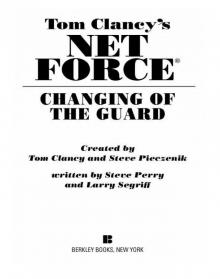 Changing of the Guard
Changing of the Guard Clear and Present Danger
Clear and Present Danger Hounds of Rome
Hounds of Rome Breaking Point
Breaking Point Tom Clancy's Jack Ryan Books 7-12
Tom Clancy's Jack Ryan Books 7-12 Full Force and Effect
Full Force and Effect The Archimedes Effect
The Archimedes Effect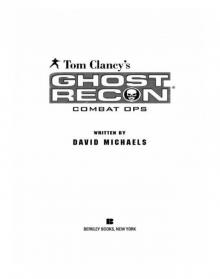 Combat Ops
Combat Ops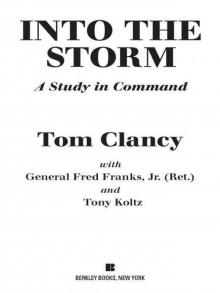 Into the Storm: On the Ground in Iraq
Into the Storm: On the Ground in Iraq Under Fire
Under Fire Point of Impact
Point of Impact Red Rabbit
Red Rabbit Rainbow Six
Rainbow Six The Hunt for Red October
The Hunt for Red October The Teeth of the Tiger
The Teeth of the Tiger Conviction (2009)
Conviction (2009) Battle Ready
Battle Ready Patriot Games
Patriot Games The Sum of All Fears
The Sum of All Fears Fallout (2007)
Fallout (2007) Red Storm Rising
Red Storm Rising The Cardinal of the Kremlin
The Cardinal of the Kremlin Executive Orders
Executive Orders Lincoln, the unknown
Lincoln, the unknown Threat Vector
Threat Vector The Hunted
The Hunted Shadow Warriors: Inside the Special Forces
Shadow Warriors: Inside the Special Forces End Game
End Game Special Forces: A Guided Tour of U.S. Army Special Forces
Special Forces: A Guided Tour of U.S. Army Special Forces Locked On
Locked On Line of Sight
Line of Sight Tom Clancy Enemy Contact - Mike Maden
Tom Clancy Enemy Contact - Mike Maden Fighter Wing: A Guided Tour of an Air Force Combat Wing
Fighter Wing: A Guided Tour of an Air Force Combat Wing Springboard
Springboard Line of Sight - Mike Maden
Line of Sight - Mike Maden EndWar
EndWar Dead or Alive
Dead or Alive Tom Clancy Support and Defend
Tom Clancy Support and Defend Checkmate
Checkmate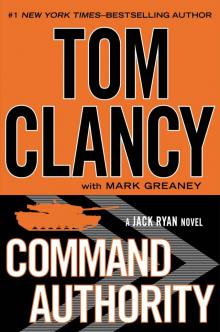 Command Authority
Command Authority Carrier: A Guided Tour of an Aircraft Carrier
Carrier: A Guided Tour of an Aircraft Carrier Blacklist Aftermath
Blacklist Aftermath Marine: A Guided Tour of a Marine Expeditionary Unit
Marine: A Guided Tour of a Marine Expeditionary Unit Commander-In-Chief
Commander-In-Chief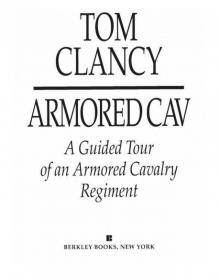 Armored Cav: A Guided Tour of an Armored Cavalry Regiment
Armored Cav: A Guided Tour of an Armored Cavalry Regiment Tom Clancy's Jack Ryan Books 1-6
Tom Clancy's Jack Ryan Books 1-6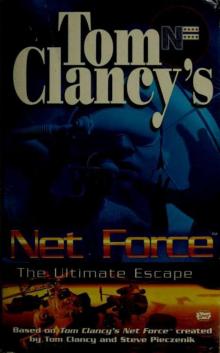 The Ultimate Escape
The Ultimate Escape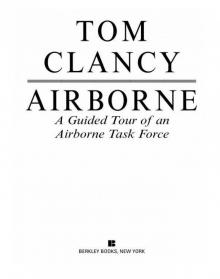 Airborne: A Guided Tour of an Airborne Task Force
Airborne: A Guided Tour of an Airborne Task Force Debt of Honor
Debt of Honor Cyberspy
Cyberspy Point of Contact
Point of Contact Operation Barracuda (2005)
Operation Barracuda (2005) Choke Point
Choke Point Power and Empire
Power and Empire Every Man a Tiger: The Gulf War Air Campaign
Every Man a Tiger: The Gulf War Air Campaign Endgame (1998)
Endgame (1998) EndWar: The Missing
EndWar: The Missing Splinter Cell (2004)
Splinter Cell (2004) The Great Race
The Great Race True Faith and Allegiance
True Faith and Allegiance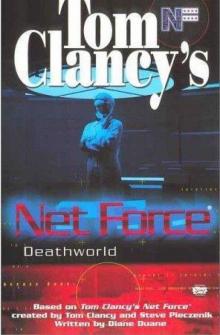 Deathworld
Deathworld Ghost Recon (2008)
Ghost Recon (2008) Duel Identity
Duel Identity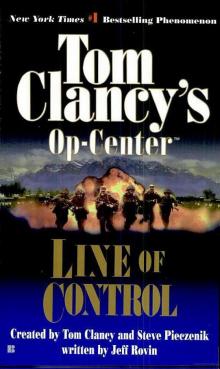 Line of Control o-8
Line of Control o-8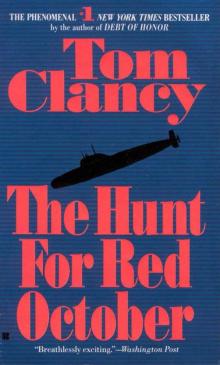 The Hunt for Red October jr-3
The Hunt for Red October jr-3 Hidden Agendas nf-2
Hidden Agendas nf-2 Acts of War oc-4
Acts of War oc-4 Ruthless.Com pp-2
Ruthless.Com pp-2 Night Moves
Night Moves The Hounds of Rome - Mystery of a Fugitive Priest
The Hounds of Rome - Mystery of a Fugitive Priest Into the Storm: On the Ground in Iraq sic-1
Into the Storm: On the Ground in Iraq sic-1 Threat Vector jrj-4
Threat Vector jrj-4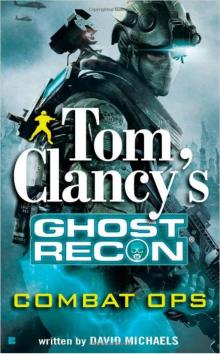 Combat Ops gr-2
Combat Ops gr-2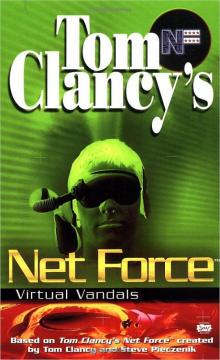 Virtual Vandals nfe-1
Virtual Vandals nfe-1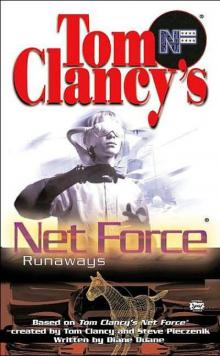 Runaways nfe-16
Runaways nfe-16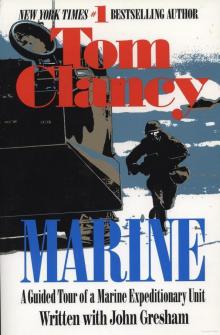 Marine: A Guided Tour of a Marine Expeditionary Unit tcml-4
Marine: A Guided Tour of a Marine Expeditionary Unit tcml-4 Shadow Warriors: Inside the Special Forces sic-3
Shadow Warriors: Inside the Special Forces sic-3 Jack Ryan Books 1-6
Jack Ryan Books 1-6 Cold Case nfe-15
Cold Case nfe-15 Changing of the Guard nf-8
Changing of the Guard nf-8 Splinter Cell sc-1
Splinter Cell sc-1 Battle Ready sic-4
Battle Ready sic-4 The Bear and the Dragon jrao-11
The Bear and the Dragon jrao-11 Fighter Wing: A Guided Tour of an Air Force Combat Wing tcml-3
Fighter Wing: A Guided Tour of an Air Force Combat Wing tcml-3 Patriot Games jr-1
Patriot Games jr-1 Jack Ryan Books 7-12
Jack Ryan Books 7-12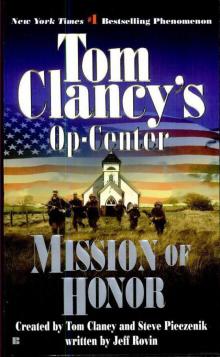 Mission of Honor o-9
Mission of Honor o-9 Private Lives nfe-9
Private Lives nfe-9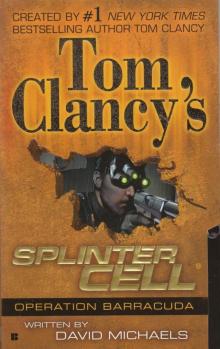 Operation Barracuda sc-2
Operation Barracuda sc-2 Cold War pp-5
Cold War pp-5 Point of Impact nf-5
Point of Impact nf-5 Red Rabbit jr-9
Red Rabbit jr-9 The Deadliest Game nfe-2
The Deadliest Game nfe-2 Springboard nf-9
Springboard nf-9 Safe House nfe-10
Safe House nfe-10 EndWar e-1
EndWar e-1 Duel Identity nfe-12
Duel Identity nfe-12 Deathworld nfe-13
Deathworld nfe-13 Politika pp-1
Politika pp-1 Rainbow Six jr-9
Rainbow Six jr-9 Tom Clancy's Power Plays 1 - 4
Tom Clancy's Power Plays 1 - 4 Endgame sc-6
Endgame sc-6 Executive Orders jr-7
Executive Orders jr-7 Net Force nf-1
Net Force nf-1 Call to Treason o-11
Call to Treason o-11 Locked On jrj-3
Locked On jrj-3 Against All Enemies
Against All Enemies The Sum of All Fears jr-7
The Sum of All Fears jr-7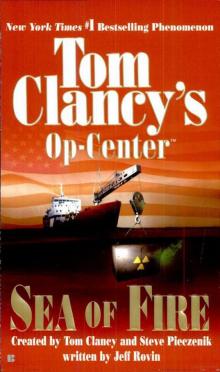 Sea of Fire o-10
Sea of Fire o-10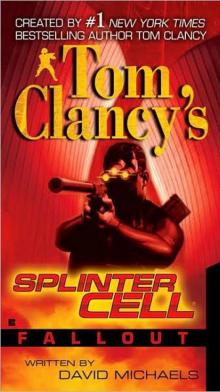 Fallout sc-4
Fallout sc-4 Balance of Power o-5
Balance of Power o-5 Shadow Watch pp-3
Shadow Watch pp-3 State of War nf-7
State of War nf-7 Wild Card pp-8
Wild Card pp-8 Games of State o-3
Games of State o-3 Death Match nfe-18
Death Match nfe-18 Against All Enemies mm-1
Against All Enemies mm-1 Every Man a Tiger: The Gulf War Air Campaign sic-2
Every Man a Tiger: The Gulf War Air Campaign sic-2 Cybernation nf-6
Cybernation nf-6 Support and Defend
Support and Defend Night Moves nf-3
Night Moves nf-3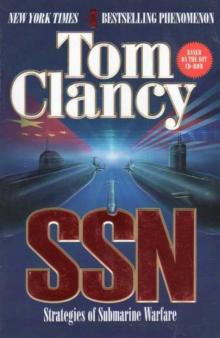 SSN
SSN Cutting Edge pp-6
Cutting Edge pp-6 The Cardinal of the Kremlin jrao-5
The Cardinal of the Kremlin jrao-5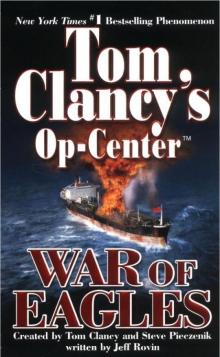 War of Eagles o-12
War of Eagles o-12 Op-Center o-1
Op-Center o-1 Mirror Image o-2
Mirror Image o-2 The Archimedes Effect nf-10
The Archimedes Effect nf-10 Teeth of the Tiger jrj-1
Teeth of the Tiger jrj-1 Bio-Strike pp-4
Bio-Strike pp-4 State of Siege o-6
State of Siege o-6 Debt of Honor jr-6
Debt of Honor jr-6 Zero Hour pp-7
Zero Hour pp-7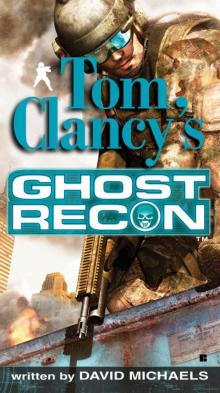 Ghost Recon gr-1
Ghost Recon gr-1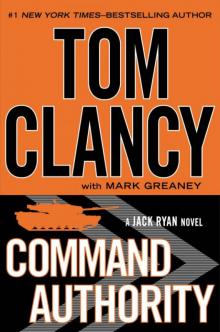 Command Authority jr-10
Command Authority jr-10 Tom Clancy's Power Plays 5 - 8
Tom Clancy's Power Plays 5 - 8 Checkmate sc-3
Checkmate sc-3 Breaking Point nf-4
Breaking Point nf-4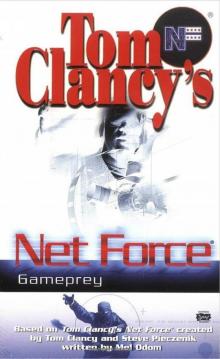 Gameprey nfe-11
Gameprey nfe-11 The Hunted e-2
The Hunted e-2 Hidden Agendas
Hidden Agendas Divide and Conquer o-7
Divide and Conquer o-7